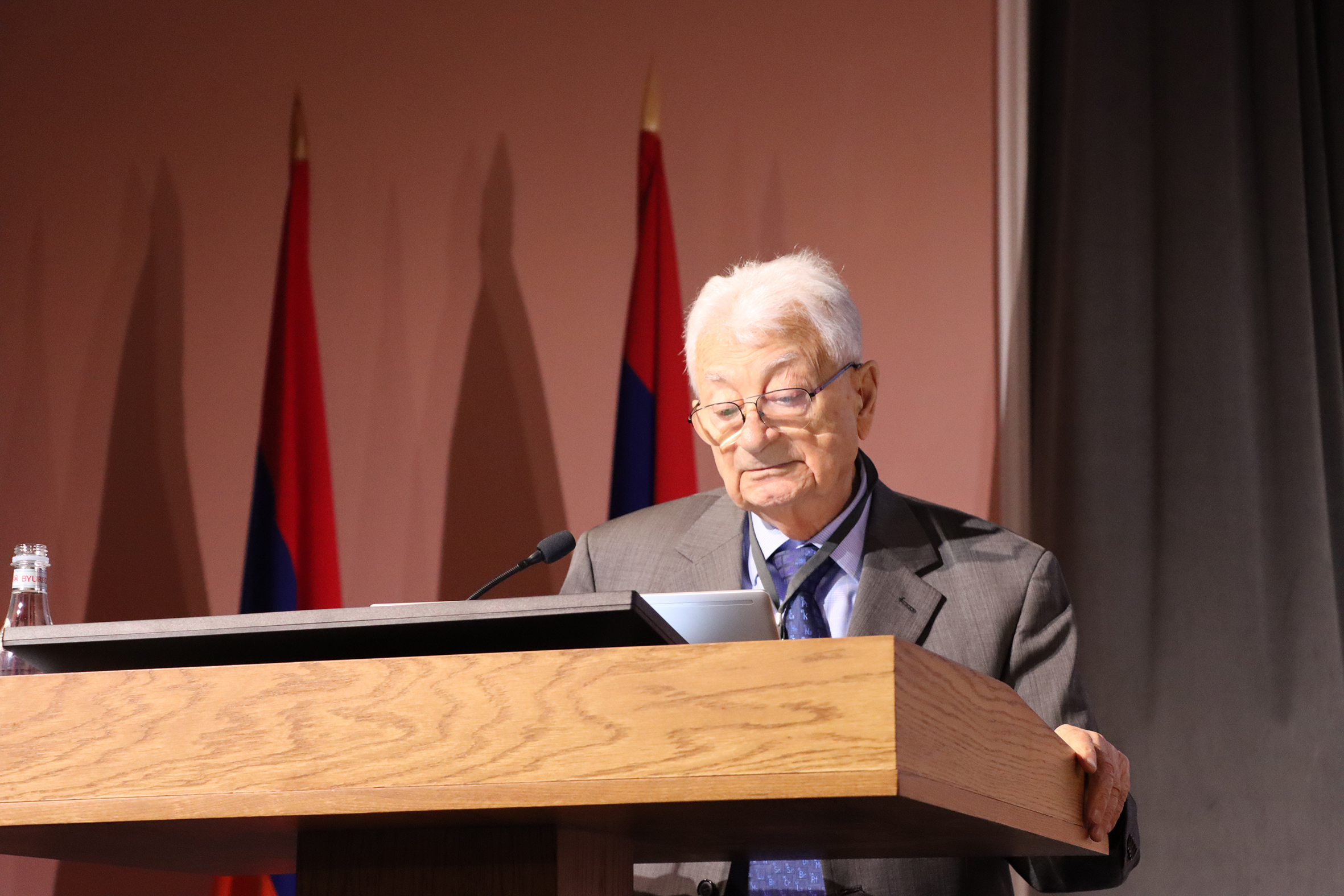50 Years of Cold Fusion conference taking place in Yerevan
News, 20 November 2024
The 50 Years of Cold Fusion international conference, organized by the National Academy of Sciences of the Republic of Armenia and the Joint Institute for Nuclear Research, is taking place in Yerevan from 19 to 24 November. The conference brought together scientists from all over the world, including Europe, Asia, and America.
September 2024 marked the 50th anniversary of the discovery of cold fusion reactions. In 1974, a new class of reactions was discovered in Dubna under the leadership of Yuri T. Oganessian, cold fusion of massive nuclei. For half a century, these reactions have been used all around the world to synthesise and study the properties of transactinide elements. This method allowed the leading laboratories of JINR, Germany, and Japan to synthesise elements with atomic numbers from 107 to 113.
On 20 November, JINR Director, Academician of the Russian Academy of Sciences (RAS) Grigory Trubnikov, President of the National Academy of Sciences of Armenia (NAS RA) Ashot Saghyan, and Academician-Secretary of the NAS RA Division of the Natural Sciences Rouben Aroutiounian spoke at the opening of the conference.
In opening remarks, Grigory Trubnikov noted that the year of the 50th anniversary of the first experiments on cold fusion of atomic nuclei is symbolic not only for JINR, but also for all world laboratories that work with nuclear reactions. He added that the tradition of holding regular conferences to discuss the results of research on the synthesis and properties of superheavy elements should be preserved. “Many elements were synthesised in cooperation between Dubna, Germany, the United States, and other countries, and the very names of these elements, hassium, darmstadt, nihonium, symbolise international partnership. We continue to conduct joint experiments with our European and new Chinese colleagues,” said JINR Director.
In his speech, President of the National Academy of Sciences of Armenia Ashot Saghyan commented on the NAS RA activities and structure. “Our Academy conducts the most significant research of global importance in astrophysics, IT, applied mathematics and mechanics, physics, chemistry, biology, Armenian studies, and a number of other branches of science,” he noted. Ashot Saghyan emphasised that nowadays the Academy plays host to many world-renowned scientists from different countries, partnership with with whom it appreciates very highly. “This symposium, dedicated to the 50th anniversary of the discovery of cold fusion reactions, is a good opportunity not only to reflect on the past, but also to review the whole issue of the synthesis of superheavy elements considering modern attitude and capabilities,” the NAS RA President said.
Scientific Leader of the JINR Laboratory of Nuclear Reactions, RAS Academician Yuri Oganessian commented on the event, stating that the influence of any discovery becomes obvious only on historical distance. “The discovery of cold fusion has already been replaced by other findings, and elements heavier than ones obtained by cold fusion have been discovered. At first, this method was used by Dubna scientists, then many laboratories around the world joined in and achieved high results. This topic drew a lot of attention, and new opportunities and ideas appeared. In this sense, cold fusion is only one step in the creation of synthetic elements, with humans starting to do what nature does, but in a different way, based on all the available knowledge,” Yuri Oganessian explained. Old approaches get replaced by the new ones. Initially, a group of American scientists led by Glenn Seaborg developed a method of bombarding actinide targets with neutrons, protons, deuterons, and helium nuclei. Then Dubna scientists contributed to the development of heavy ion bombardment. “Then, the discovery of cold fusion proved that in this complex transformation, counting numerous particles, there are certain configurations that physicists call magical and which begin to make an impact due to the fact that the bond of these particles is greater than average. Today we have already moved from cold fusion to 48Ca reactions, which gave us the opportunity to synthesise all the elements that cold fusion does not “reach”, from 114 to 118,” Academician Oganessian said. He added that the experiments on synthesising elements 119 and 120 will be a continuation of the creation of the elements mentioned above.
The conference will include sections on the cold nuclear fusion of superheavy elements (SHE), heavy ion nuclear reactions, and the physical and chemical properties of SHE. There will be a discussion on mechanisms of the fusion reaction, the progress in synthesis facilities, SHE studies by world’s leading centres, and prospects for the development of experimental and theoretical research.
Many world-renowned scientists in the synthesis and description of the properties of chemical elements will deliver presentations at the event. Among the speakers are researchers from Bulgaria, China, France, Germany, Israel, Japan, Poland, Romania, Russia, Sweden, Switzerland, and United Kingdom. At the beginning of the conference, Yuri Oganessian talked about the cold fusion of massive nuclei. Peter Möller (Lund University, Sweden) gave a speech on the chronology of great theoretical developments that led to current understanding of the heavy elements stability. Christoph Düllmann (Germany) made a presentation on the application of the cold fusion at the Helmholtz Centre for Heavy Ion Research. A speech by Feng-Shou Zhang (Beijing Normal University, China) was devoted to various ways of synthesising superheavy elements.









